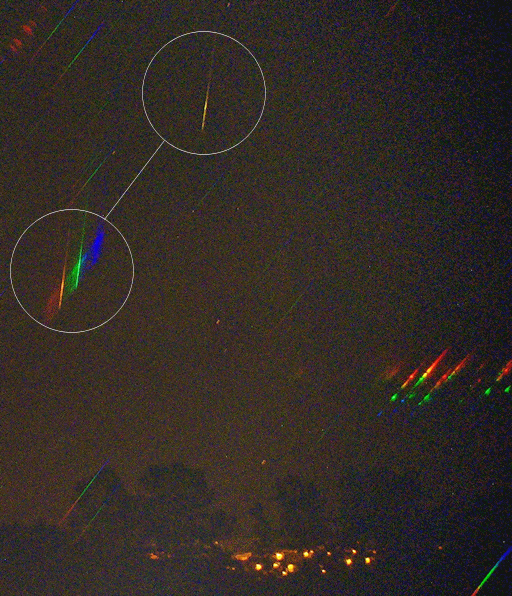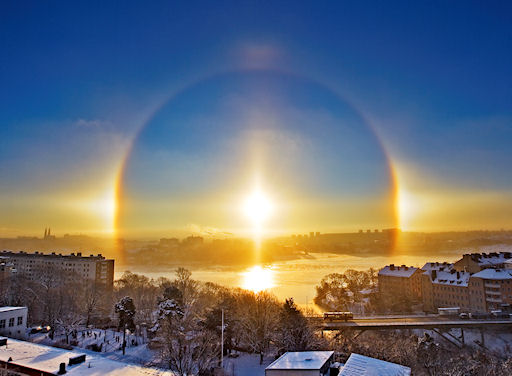iPHONE VS ANDROID! Actually, it doesn't matter which phone you carry. Our cool, new app turns both smartphones into field-tested satellite trackers. Learn more. | | |
AURORA WATCH: NOAA forecasters have downgraded the chances of geomagnetic activity during the next 24 hours to 25%. Even so, high-latitude sky watchers should remain alert for auroras as a solar wind stream approaches Earth.
GEMINID METEOR UPDATE: Go outside at midnight and stare at the sky for six minutes. Right now, that's about how long it takes to see a Geminid meteor, according to counts posted by the International Meteor Organization. The pace will pick up in the nights ahead as Earth plunges deeper into the Geminid debris stream. On peak night, Dec. 13th-14th, meteor rates could jump as high as 120 per hour, reducing the wait from six minutes to a mere 30 seconds.
On Dec. 10th, amateur astronomer Marsha Adams photographed a bright Geminid over Sedona, Arizona. "I passed the light through a diffraction grating to record both the meteor and its spectrum." See the circled pair, below:

The other spectra in the image correspond to stars and city lights. Adams notes that the Geminid spectrum is different. "It has two bright lines, one green and one yellow-red, [features which are absent in the other spectra]." These spectral lines may be clues to the chemical make-up and mysterious origin of Geminid meteoroids.
Stay tuned for more colorful Geminids in the nights ahead.
PLAN B: Got clouds? If you can't see the Geminids, you can listen to them instead on Space Weather Radio. We're transmitting live meteor echoes from the US Air Force Space Surveillance Radar in Kickapoo, Texas.
BUSY ICE HALO: In Stockholm, Sweden, the sun was only up for a little while Wednesday, but it made good use of its time. Sunbeams lanced through ice crystals in the air, producing a busy halo of surpassing beauty:

"This was the most spectacular sun halo I have seen in recent years from Stockholm," says photographer Peter Rosén. "It was visible for the whole (short) day." In addition to the sundogs, upper tangent arc, and 22° halo captured in the snapshot above, Rosén also witnessed "a 46° outer halo and a circumzenithal arc as ice crystals blew in gusts across the sun. What a show!"
Now is the time of year when low-hanging suns shine through high-floating ice to produce such vistas. People of the northern hemisphere should be alert for halos.
more images: from Jörgen Blom of Stockholm, Sweden; from Merelyn Davis of Burbank, CA; from Paul Ballard of Kungälv, Sweden; from Gary Brekke of Fargo, ND; from Shawn Johnston of Fargo, ND; from Joanna Fengler of Poznan, Poland
November 2010 Aurora Gallery
[previous Novembers: 2009, 2008, 2007, 2006, 2004, 2003, 2002, 2001, 2000]
Potentially Hazardous Asteroids (
PHAs) are space rocks larger than approximately 100m that can come closer to Earth than 0.05 AU. None of the known PHAs is on a collision course with our planet, although astronomers are finding
new ones all the time.
On December 11, 2010 there were 1167 potentially hazardous asteroids.
Notes: LD means "Lunar Distance." 1 LD = 384,401 km, the distance between Earth and the Moon. 1 LD also equals 0.00256 AU. MAG is the visual magnitude of the asteroid on the date of closest approach. | | The official U.S. government space weather bureau |
| | The first place to look for information about sundogs, pillars, rainbows and related phenomena. |
| | Researchers call it a "Hubble for the sun." SDO is the most advanced solar observatory ever. |
| | 3D views of the sun from NASA's Solar and Terrestrial Relations Observatory |
| | Realtime and archival images of the Sun from SOHO. |
| | from the NOAA Space Environment Center |
| | the underlying science of space weather |

